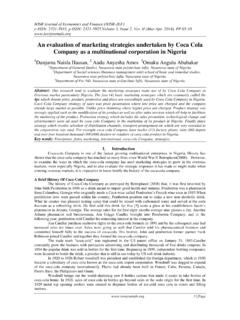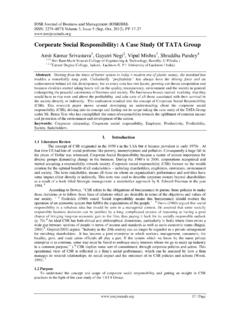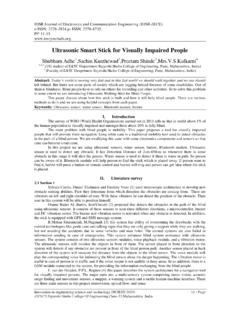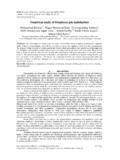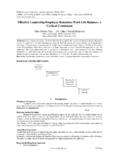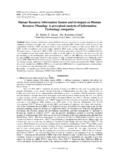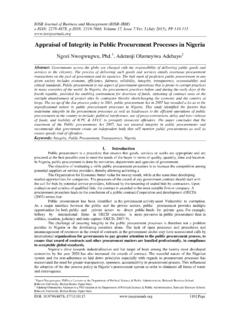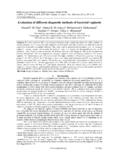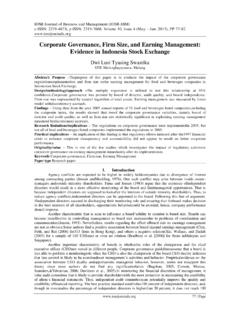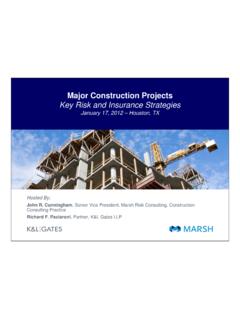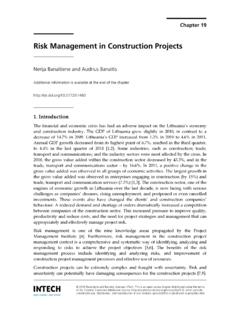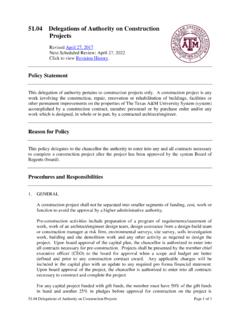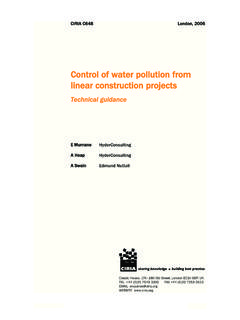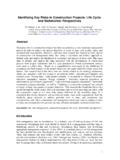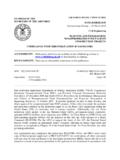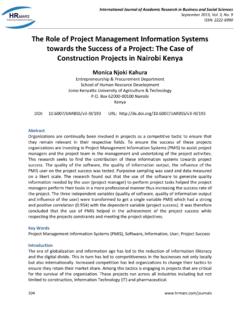Transcription of Scheduling Repetitive Construction Projects Using Fuzzy ...
1 IOSR Journal of Mechanical and Civil Engineering (IOSR-JMCE). ISSN: 2278-1684 Volume 4, Issue 2 (Nov. - Dec. 2012), PP 13-22. Scheduling Repetitive Construction Projects Using Fuzzy Linear Programming A. M. El-Kholy (Civil Engineering Department, Engineering Faculty / Beni Suef University, Egypt). Abstract: Scheduling problem for Repetitive Construction Projects involves three conflicting objectives. These objectives are project duration, project total cost, and project total interruption time. This paper presents a multi-objective Fuzzy linear programming model (FLP) for resolving this problem. Literature concerned with Scheduling problems for Repetitive Construction Projects was reviewed. Multi-objective Fuzzy linear programming was then explained. The proposed model formulation was then presented.
2 A bridge project from pertinent literature was selected for model validation purpose. An optimization of each individual objective was performed with a linear programming (LP) software (Lindo) that gave the upper and lower bounds for the multi-objective analysis. Fuzzy linear programming was then applied to optimize the solution. Two scenarios were adopted in solution. In the first scenario, the three above objectives were considered simultaneously. Analysis of the results revealed that project duration, and project total cost are deviated only by , and , respectively as compared to their corresponding ideal values in the crisp LP. model. On the other hand, the percentage of total interruption time to project duration in FLP is against zero in LP. In the second scenario, each two objectives were considered in a single run.
3 The purpose is to explain how can the model's user generate and evaluate the optimal tradeoff solution between any two objectives that suit his demands. Keywords: Fuzzy Linear Programming; Linear Programming; Repetitive Construction Projects ; Multi Objective Analysis. I. Introduction Linear Repetitive Construction Projects require large amounts of resources which are used in a sequential manner. Therefore effective resource management is very important in terms of project total cost, duration, and interruption time. Interruption time in Repetitive Projects is the queuing time between two activities of the same type at two consecutive units (Liu and Wang) [1]. The methodologies such as critical path method and the Repetitive Scheduling method optimize the schedule with respect to a single factor.
4 This factor may be to achieve minimum project duration, project total cost, or to minimize resource work breaks. However, real life Scheduling decisions are more complicated and project managers must make decisions that address the various cost elements in a holistic way (Ipsilandis) [2]. LP is a technique that widely used for optimal decision-making in a rigid environment. In LP model, the objective function and the constraints cannot be represented precisely in linguistic form causing difficulty in representing a real world problem. Usually, decision making in real world takes place in an environment in which the goals, constraints and the consequences of possible actions are not known precisely. Uncertainty has been one of the major factors that influence project performance and determines its ultimate success.
5 To obtain more realistic solution to the problems, a degree of flexibility is required to be introduced into the crisp constraint inequalities. Accordingly, certain degree of flexibility is to be incorporated in the model parameters of the LP solution to optimize more than one objective simultaneously. Fuzziness in the problem stems from the imprecise aspiration levels attained by the decision maker to the objectives. The objective function of the FLP is to maximize the membership value of intersection of the objectives, which forms the Fuzzy decision (Faheem et al.) [3]. This paper introduces a multi objective Fuzzy linear programming model for Scheduling Repetitive Construction Projects , which takes into consideration project duration, project total cost, and total interruption time simultaneously.
6 Chang et al. [4] explained the advantage of Fuzzy multi objective optimization over deterministic approach as; 1) Fuzzy uncertainties embedded in the model parameters can be directly reflected and communicated into the optimization process; 2) the variation of the decision maker's aspiration level in the model can be incorporated and thereby generate a more confident solution set for decision maker; 3) Regardless of the orientation of decision maker's aspiration level (maximization or minimization), each objective has it's own independent membership function and different aspiration level. The paper is organized as follows. The first section is devoted to review literature concerned with linear Scheduling problems. The second section explains Fuzzy linear programming as an optimization 13 | Page Scheduling Repetitive Construction Projects Using Fuzzy Linear Programming technique.
7 The third section presents the proposed model formulation. Following, a bridge project from pertinent literature is selected for model validation purpose. Analysis of the bridge example helps indicate the contributions of the proposed model. Conclusions are drawn in the last section. II. Literature Review Numerous techniques for handling linear Scheduling problems have been developed in recent decades. Some studies have adopted heuristic algorithm for Repetitive activity Scheduling process such as Bragadin and Kahkonen [5]. The algorithm is a semi/automatic procedure that can help inexperienced planner in Repetitive Construction project Scheduling . The optimization process carry out resource timing in two phases: resource . space network implementation and schedule optimization. In the first phase a traditional Precedence Diagramming Method network is plotted on a resource space chart and the as soon as possible project schedule is performed.
8 In the second phase the algorithm search for resource Scheduling optimization by minimization of resource idle time in every resource path on Repetitive space units. The work continuity constraint is relaxed in order to maintain the Precedence Diagramming Method minimum project duration. Ammar [6] proposed an integrated CPM and LOB model to schedule Repetitive Projects in an easy non graphical way considering both logic dependency and resource continuity constraints. Overlapping activities of a single typical unit are used to model duration and logical relationships of Repetitive activities. Another studies used dynamic programming such as Selinger [7] to minimize project duration for linear Construction Projects . Russell and Caselton [8] extended the work of Selinger in developing a two state variable, N-stage dynamic programming formulation that minimizes the duration of linear Construction Projects .
9 Handa and Barcia [9] presented an integer dynamic programming model to optimize the project duration. Additional research has utilized dynamic programming in minimizing total cost or project duration by integrating cost, time, or heuristic rules (El-Rayes and Moselhi; Moselhi and El-Rayes; Senouci and El-din;. Moselhi and Hassanien)[10-13]. Another group of studies have adopted linear programming and integer programming. Perera [14]. proposed a linear programming model to maximize the Construction rate of the activities in a Repetitive project . Reda [15] utilized a linear programming formulation to minimize the project direct cost for a given project duration. Huang and Halpin [16] proposed a graphical based approach called POLO system to assist in the linear programming modeling of linear Scheduling problems.
10 Mattila and Abraham [17] presented an integer programming model for leveling the resources of activities in a linear Construction project . Given the rapid development of computer based techniques, researchers have used artificial intelligence techniques, such as knowledge based systems, neural networks and genetic algorithm to solve the increasing complexity of Construction Projects . For example, Shaked and Warszawskiz [18] developed a knowledge based system for Construction planning of high rise buildings. Adeli and Kariem [19] developed a neural dynamic model to schedule and optimize Repetitive Projects . They applied the model for highway Construction Scheduling . Hegazy and Ayed [20] used a neural network approach to manage Construction cost data and developed a parametric cost estimating model for highway Projects .
